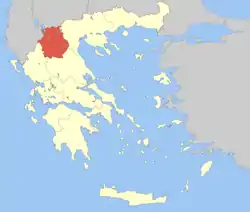Nestorio
Nestorio (Greek: Νεστόριο, Nestório; Macedonian: Нестрам, Nestram; Bulgarian: Нестрам, Nestram or Нѐсрам, Nésram)[2][3][4] is a village and a municipality in the Kastoria regional unit of Macedonia, Greece. Nestorio is approximately 28 km southwestwards of Kastoria, at the banks of the river Aliakmon.
Nestorio
Νεστόριο | |
|---|---|
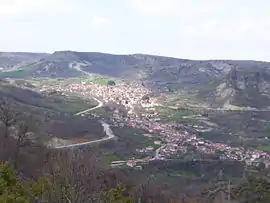 Panoramic view | |
 Nestorio Location within the region 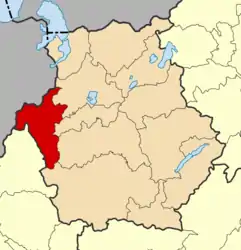 | |
| Coordinates: 40°24′N 21°3′E | |
| Country | Greece |
| Administrative region | West Macedonia |
| Regional unit | Kastoria |
| Area | |
| • Municipality | 616.1 km2 (237.9 sq mi) |
| • Municipal unit | 336.3 km2 (129.8 sq mi) |
| Highest elevation | 1,700 m (5,600 ft) |
| Lowest elevation | 900 m (3,000 ft) |
| Population (2011)[1] | |
| • Municipality | 2,646 |
| • Municipality density | 4.3/km2 (11/sq mi) |
| • Municipal unit | 1,411 |
| • Municipal unit density | 4.2/km2 (11/sq mi) |
| Community | |
| • Population | 964 (2011) |
| Time zone | UTC+2 (EET) |
| • Summer (DST) | UTC+3 (EEST) |
| Postal code | 520 51 |
| Vehicle registration | AT |
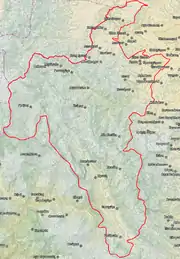
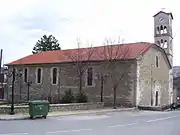
Municipality
The municipality Nestorio was formed at the 2011 local government reform by the merger of the following 4 former municipalities, that became municipal units:[5]
The municipality has an area of 616.072 km2, the municipal unit 336.326 km2.[6]
Subdivisions
The municipal unit of Nestorio is divided into the following communities:
- Kypseli
- Kotyli
- Nestorio
- Ptelea
History
The area was ruled by the Ottoman Empire until the Balkan Wars of 1912-13, in the late 19th and early 20th century as part of Manastir Vilayet. The population of Nestram consisted of an older local Slavic speaking population and a small Aromanian population that originated from the nearby village of Linotopi on the Gramos mountains that were later assimilated by the Slavonic villagers.[7] At the beginning of the twentieth century, in Nestram there were 16 Aromanian speaking families and 455 Slavic speaking families.[7] Nestram had 2,700 inhabitants in the beginning of the 20th century and most of them were Slavophone (Slavic speaking) Orthodox Christians and a few of them Aromanians. In the early 20th century the majority of the inhabitants of Nestram accepted the rule of the Bulgarian Exarchate. According to the statistics of Vasil Kanchov (Macedonia. Ethnography and Statistics) the inhabitants of Nestram in 1900 were Bulgarians.[8]
Nestram, along with the rest of southern Macedonia, was incorporated into Greece in 1913 following the Balkan Wars. The village was known as Nestrami (Greek: Νεστράμι) until 1926 when it was renamed as Agios Nestor (Greek: Άγιος Νέστωρ).[9] In 1928, the village received its current Greek name Nestorion (Greek: Νεστόριον).[10]
In the modern period, the village is Slavic speaking with a Greek orientation.[11] Field work conducted recently showed only a rudimentary competence in Slavic among the village's inhabitants.[11]
Culture
The village holds an annual rock festival in late-July, called 'River Party'.[12] River Party started in 1978. The bands come from the Greek rock scene, especially from Athens and Thessaloniki and with foreign guests, including from the wider region.[13]
Population
| Year | Community | Municipal unit | Municipality |
|---|---|---|---|
| 1981 | 1,233 | - | - |
| 1991 | 1,158 | 1,928 | - |
| 2001 | 1,214 | 1,782 | - |
| 2011 | 964 | 1,411 | 2,646 |
Notable people
- Ioannis Skoutaris (17th century), Byzantine style painter
- Keraca Visulčeva - prominent Macedonian artist (1911–2004)
References
- "Απογραφή Πληθυσμού - Κατοικιών 2011. ΜΟΝΙΜΟΣ Πληθυσμός" (in Greek). Hellenic Statistical Authority.
- Ethnographie des Vilayets d'Adrianople, de Monastir et de Salonique, Constantinople, 1878. OCLC 12139947.
- „Македония и Одринско. Статистика на населението от 1873 г.“ Македонски научен институт, София, 1995, с. 110-111.
- "Научна експедиция в Македония и Поморавието,1916 г. съст. Петър Хр. Петров".
- Kallikratis law Greece Ministry of Interior (in Greek)
- "Population & housing census 2001 (incl. area and average elevation)" (PDF) (in Greek). National Statistical Service of Greece.
- Koukoudis, Asterios (2003). The Vlachs: Metropolis and Diaspora. Thessaloniki: Zitros Publications. pp. 334, 383. ISBN 9789607760869.CS1 maint: ref=harv (link)
- Васил Кънчов. „Македония. Етнография и статистика“. София, 1900, c. 266. (Kanchov, Vasil. Macedonia — ethnography and statistics, Sofia, 1900, p. 266.
- "Πανδέκτης: Nestrami -- Agios Nestor". Retrieved 2019-09-19. Pandektis: Name Changes of Settlements in Greece, compiled by the Institute for Neohellenic Research
- "Πανδέκτης: Agios Nestor -- Nestorion". Retrieved 2019-09-19. Pandektis: Name Changes of Settlements in Greece, compiled by the Institute for Neohellenic Research
- Rossini, Claudia (2003). "Graecophiles and Macedonophiles: Greek Macedonia's Slavic-Speakers, the Minority Identity Question and the Clash of Identities at Village Level". Jahrbücher für Geschichte und Kultur Südosteuropas 5. 5: 181.CS1 maint: ref=harv (link)"the Slavic-speaking, but traditionally Greek orientated village of Nestorio (prefecture of Kastoria)"
- River Party website (Partially Greek)
- Ξεκινά σήμερα το 31ο River Party στο Νεστόριο της Καστοριάς (Greek)
External links
| Wikimedia Commons has media related to Nestorio. |
- Official Site of Nestorio (in Greek)
- ( Helsinki Report )
- Nestorio on GTP Travel Pages
